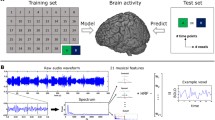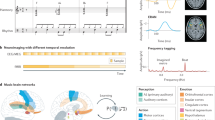Abstract
The experience of hearing sounds not present in the air around us has been explored by composers, artists, and researchers for decades. Understanding and communicating the experience of these imagined sounds is often at the core of these explorations. This chapter presents guidelines and best practices for designing frameworks to decode imagined sound. The guidelines explore various design considerations and provide a detailed taxonomy of imagined sound for additional clarity. The second-half of the chapter details the design and results of a contemporary example of the decoding of imagined sound through a brain imaging study where decoding involves machine learning of the pattern of brain activity associated with specific properties imagining of sound, such as pitch-class and timbre, and then estimating those properties from novel data. The discussion of the study outlines the successful decoding of pitch-class and timbral information from brain scans of trained musicians imagining individual musical notes.
Access this chapter
Tax calculation will be finalised at checkout
Purchases are for personal use only
Similar content being viewed by others
Notes
- 1.
Image here refers to the mental representation of the object which can include multiple senses simultaneously and does not necessitate an imagined visual component.
- 2.
- 3.
We use the term perceived in this section strictly as it pertains to this line of inquiry. While other terms, such as primarily-acoustic or cochlear-listening, may have been used here, we chose to use perceived to maintain a clear connection with the preceding literature.
- 4.
The minimum cluster size cut-off was 40 voxels and only included voxels that shared a common face.
References
Adrian, Edgar Douglas, and Brian H.C. Matthews. 1934. The berger rhythm: potential changes from the occipital lobes in man. Brain 57 (4): 355–385.
Baddeley, Alan, and Robert Logie. 1992. Auditory imagery and working memory. In Auditory Imagery, D. reisberg, ed. 179–197. Lawrence Erlbaum Associates, Inc.
Beisteiner, Roland, E. Altenmuller, W. Lang, G. Lindinger, and L. Deecke. 1994. Musicians processing music: measurement of brain potentials with eeg. European Journal of Cognitive Psychology 6 (3): 311–327.
Berger, Hans. 1933. Über das elektrenkephalogramm des menschen. European Archives of Psychiatry and Clinical Neuroscience 98 (1): 231–254.
Bigler, Erin D., Sherstin Mortensen, E. Shannon Neeley, Sally Ozonoff, Lori Krasny, Michael Johnson, Lu Jeffrey, Sherri L. Provencal, William McMahon, and Janet E. Lainhart. 2007. Superior temporal gyrus, language function, and autism. Developmental Neuropsychology 31 (2): 217–238.
Brodsky, Warren, Avishai Henik, Bat-Sheva Rubinstein, and Moshe Zorman. 2003. Auditory imagery from musical notation in expert musicians. Perception & Psychophysics 65 (4): 602–612.
Bunzeck, Nico, Torsten Wuestenberg, KaiLutz, Hans Jochen Heinze, and Lutz Jancke.2005. Scanning silence: Mental imagery of complex sounds. NeuroImage 26 (4):1119–1127. issn: 10538119.https://doi.org/10.1016/j.neuroimage.2005.03.013.
Bzdok, Danilo, Gesa Hart, and wigsen, Andrew Reid, Angela R Laird, Peter T Fox, and Simon B Eickhoff. 2016. Left inferior parietal lobe engagement in social cognition and language. Neuroscience & Bio behavioral Reviews 68: 319–334.
Cage, John. 1962. The future of music: credo. Music Journal 20 (1): 44.
Casey, Michael, Jessica Thompson, Olivia Kang, Rajeev Raizada, and Thalia Wheatley. 2012. Population codes representing musical timbre for high-level fmri categorization of music genres. In Machine Learning and Interpretation in Neuroimaging, 34–41. Springer.
Clark, Graeme. 2004. Cochlear Implants, 422–462. NewYork, NY: Springer.
Coleridge, S. 1817. Biographia Literaria; or, Biographical Sketches of My Literary Life and Opinions: v.2. London: RestFenner.
Crowder, Robert G. 1989. Imagery for musical timbre. Journal of Experimental Psychology: Human Perception and Performance 15 (3): 472.
Damasio, Antonio R. 1996. The somatic marker hypothesis and the possible functions of the prefrontal cortex. Philosophical Transactions of the Royal Society of London. Series B: Biological Sciences 351 (1346):1413–1420.
Deutsch, Diana. 1981. The octave illusion and auditory perceptual integration. Hearing Research and Theory 1 (99): 142.
Deutsch, Diana. 1991. The tritone paradox: an influence of language on music perception. Music Perception: An Interdisciplinary Journal 8 (4): 335–347.
Deutsch, Diana. 2013. Psychology of Music. Elsevier.
Deutsch, Diana. 2016. Illusions and Research. http://deutsch.ucsd.edu/psychology/pages.php?i=201.
Donnay, Gabriel F, Summer K. Rankin, Monica Lopez-Gonzalez, Patpong Jiradejvong, and Charles J. Limb. 2014. Neural substrates of interactive musical improvisation: an fmri study of ‘trading fours’ in jazz. PLoS One 9(2)
Dunn, Robert E. 1997. Creative thinking and music listening. Research Studies in Music Education 8 (1): 42–55.
East West. 2019a. Hollywoodbrass. [Online; accessed19-January-2020]. http://www.soundsonline.com/hollywood-brass.
East West. 2019b. Hollywood orchestral woodwinds. [Online; accessed19-January-2020]. http://www.soundsonline.com/hollywood-orchestral-woodwinds.
Eger, Evelyn, Stefan Robert Schweinberger, Raymond J. Dolan, and Richard N. Henson. 2005. Familiarity enhances invariance of face representations in human ventral visual cortex: fmri evidence. Neuroimage 26 (4): 1128–1139.
Esteban, Oscar, Christopher J. Markiewicz, Ross W. Blair, Craig A. Moodie, AIlkay Isik, Asier Erramuzpe, James D Kent, Mathias Goncalves, Elizabeth DuPre, Madeleine Snyder, et al. 2019. Fmriprep: a robust preprocessing pipeline for functional mri. Nature Methods 16 (1): 111–116.
Fisk, Josiah, and Jeff William Nichols. 1997. Composers on Music: Eight Centuries of Writings. UPNE.
Gazzaniga, Michael S, Richard B Ivry, and G R Mangun. 2006. Cognitive Neuroscience. The Biology of the Mind,(2014). Norton: New York.
Gharabaghi, Alireza, Monika Fruhmann Berger, Marcos Tatagiba, and Hans-Otto Karnath. 2006. The role of the right superior temporal gyrus in visual search-insights from intraoperative electrical stimulation. Neuropsychologia 44 (12): 2578–2581.
Gleick, James. 2011. The information: a history, a theory, a flood. New York, NY: Vintage.
Gordon, Edwin E. 1989. Audition, imitation and notation: musical thought and thought about music. The American Music Teacher 38 (5): 15.
Halpern, Andrea R. 2015. Differences in auditory imagery self-report predict neural and behavioral out comes. Psychomusicology: Music, Mind, and Brain 25 (1):37.
Halpern, Andrea R., Robert J. Zatorre, Marc Bouffard, and Jennifer A. Johnson. 2004. Behavioral and neural correlates of perceived and imagined musical timbre. Neuropsychologia 42 (9): 1281–1292.
Helthuis, Jasper HG, Albert van der Zwan,Tristan PC van Doormaal, Ronald LAW Bleys, Anita A Harteveld, Annette van der Toorn, Mariana Brozici, Jeroen Hendrikse, and Jaco JMZ wanenburg. 2018. High resolution 7t and 9.4t-mri of human cerebral arterial casts enables accurate estimations of the cerebrovascular morphometry. Scientific reports 8 (1):14235.
Herholz, Sibylle C., Andrea R. Halpern, and Robert J. Zatorre. 2012. Neuronal correlates of perception, imagery, and memory for familiar tunes. Journal of Cognitive Neuroscience 24 (6): 1382–1397.
Holmes, Jessica A. 2016. Singing beyond hearing. Colloquy: On the Disability Aesthetics of Music 69:542–48.
Hunter, Murray, etal. 2013. Imagination may be more important than knowledge: the eight types of imagination we use. Review of Contemporary Philosophy (12): 113–120.
Janata, Petr. 2001. Brain electrical activity evoked by mental formation of auditory expectations and images. Brain Topography 13 (3): 169–193.
Japee, Shruti, Kelsey Holiday, Maureen D. Satyshur, Ikuko Mukai, and Leslie GUngerleider. 2015. A role of right middle frontal gyrus in reorienting of attention: a case study. Frontiers in Systems Neuroscience 9: 23.
Kleber, Boris, Niels Birbaumer, Ralf Veit, Tracy Trevorrow, and Martin Lotze. 2007. Overt and imagined singing of an Italian aria. Neuroimage 36 (3): 889–900.
Koyama, Maki S., David O’Connor, Zarrar Shehzad, and Michael P. Milham. 2017. Differential contributions of the middle front algyrus functional connectivity to literacy and numeracy. Scientific Reports 7 (1): 1–13.
Krumhansl, CarolL, and Lola L Cuddy. 2010. A theory of tonal hierarchies in music. In Music Perception, 51–87. Springer.
Limb, Charles J., and Allen R. Braun. 2008. Neural substrates of spontaneous musical performance: an fmri study of jazz improvisation. PLoS One 3(2):
Lin, Lung-Chang, Mei-Wen Lee, Ruey-Chang Wei, Hin-Kiu Mok, and Rei-Cheng Yang. 2014. Mozart k. 448 listening decreased seizure recurrence and epileptiform discharges in children with first unprovoked seizures: a randomized controlled study. BMC Complementary and Alternative Medicine 14 (1):17.
Liu, Siyuan, Ho Ming Chow, Xu Yisheng, Michael G. Erkkinen, E.S. Katherine, and wett, Michael W Eagle, Daniel A Rizik-Baer, and Allen R Braun. 2012. Neural correlates of lyrical improvisation: an fmri study of freestyle rap. Scientific Reports 2: 834.
May, Lloyd, Sean Paulson, Andrea Halpern, and Michael Casey. 2020. Imagined musical scale relationships decoded from fMRI. In Prep.
McKeown, Martin J., LarsKai Hansen, and Terrence J. Sejnowsk. 2003. Independent component analysis of functional mri: what is signal and what is noise? Current Opinion in Neurobiology 13 (5): 620–629.
Nanay, Bence. 2010. Perception and imagination: a modal perception as mental imagery. Philosophical Studies 150 (2): 239–254.
Naselaris, Thomas,Cheryl A Olman, Dustin E Stansbury, Kamil Ugurbil, and Jack L Gallant. 2015. A voxel-wise encoding model for early visual are as decodes mental images of remembered scenes. Neuroimage 105:215–228.
Nolan, Christopher. 2017. Dunkirk.
Norman, Kenneth A., Sean M. Polyn, Greg J. Detre, and James V. Haxby. 2006. Beyond mind-reading: multi-voxel pattern analysis of fmri data. Trends in Cognitive Sciences 10 (9): 424–430.
Oliveros, Pauline. 2005. Deep Listening: A Composer’s Sound Practice. NE: IUniverse. Lincoln.
Pfordresher, Peter Q., and Andrea R. Halpern. 2013. Auditory imagery and the poor-pitch singer. Psychonomic Bulletin & Review 20 (4): 747–753.
Pitt, Mark A., and Robert G. Crowder. 1992. The role of spectral and dynamic cues in imagery for musical timbre. Journal of Experimental Psychology: Human Perception and Performance 18 (3): 728.
Podgorny, Peter, and Roger N. Shepard. 1978. Functional representations common to visual perception and imagination. Journal of Experimental Psychology: Human Perception and Performance 4 (1): 21.
Prpa, Mirjana, and Philippe Pasquier. 2019. Brain-computer interfaces in contemporary art: a state of the art and taxonomy.In Brainart, 65–115. Springer.
Radua, Joaquim, Mary L. Phillips, Natalia Lawrence TamaraRussell, Nicolette Marshall, Sridevi Kalidindi, Wissam El-Hage, Colm McDonald, Vincent Giampietro, Michael J. Brammer, et al. 2010. Neural response to specific components of fearful faces in healthy and schizophrenic adults. Neuroimage 49 (1): 939–946.
Repp, Bruno H. 2001. Expressive timing in the mind’sear. Musical Imagery:185–200.
Rosenboom, David. 1977. Bio feedback and the arts: results of early experiments. Journal of Aesthetics and Art Criticism 35 (3): 385–386.
Sewitsky, Anne. 2019. Black Mirror: Rachel, Jack and Ashley too. Netflix.
Shepard, Roger N. 1964. Circularity in judgments of relative pitch. The Journal of the Acoustical Society of America 36(12):2346–2353.
Stober, Sebastian, Thomas Prätzlich, and Meinard Müller. 2016. Brain beats: tempo extraction from eeg data.In Ismir, 276–282.
Stober, Sebastian, Avital Sternin, Adrian M Owen, and Jessica A Grahn. 2015. Towards music imagery information retrieval: introducing the openmiir dataset of eeg recordings from music perception and imagination.In Ismir, 763–769.
Straebel, Volker, and Wilm Thoben. 2014. Alvin Lucier’s music for solo performer: experimental music beyond sonification. Organised Sound 19 (1): 17–29.
Uddin, Lucina Q., Jason S. Nomi, Benjamin Hebert-Seropian, Jimmy Ghaziri, and Olivier Boucher. 2017. Structure and function of the human insula. Journal of Clinical Neurophysiology: Official Publication of the American Electroencephalographic Society 34 (4): 300.
Vidal, Jacques J. 1973. Toward direct brain-computer communication. Annual Review of Bio-physics and Bioengineering 2 (1):157–180.
Wei, Tao, Xia Liang,Yong He, Yufeng Zang, Zaizhu Han, Alfonso Caramazza, and Yanchao Bi.2012. Predicting conceptual processing capacity from spontaneous neuronal activity of the left middle temporal gyrus. Journal of Neuroscience 32(2):481–489.
Whitney, Carin, JamieO’Sullivan MarieKirk, Matthew A. Lambon, and Ralph, and Elizabeth Jefferies. 2011. The neural organization of semantic control: tms evidence for a distributed network in left inferior front al and posterior middle temporalgyrus. Cerebral Cortex 21(5): 1066–1075.
Willey, Basil. 1947. Coleridge on Imagination and Fancy. Folcroft, PA: The Folcroft Press.
Wolpaw, Jonathan, and Elizabeth Winter Wolpaw. 2012. Brain-Computer Interfaces: Principles and Practice. OUP USA.
ZA/UM. 2019. Disco elysium.
Zatorre, Robert J., and Andrea R. Halpern. 2005. Mental concerts: musical imagery and auditory cortex. Neuron 47 (1): 9–12.
Zatorre, Robert J., Andrea R. Halpern, David W. Perry, Ernst Meyer, and Alan C. Evans. 1996. Hearing in the mind’s ear: a pet investigation of musical imagery and perception. Journal of Cognitive Neuroscience 8 (1): 29–46.
Author information
Authors and Affiliations
Corresponding author
Editor information
Editors and Affiliations
Rights and permissions
Copyright information
© 2021 The Author(s), under exclusive license to Springer Nature Switzerland AG
About this chapter
Cite this chapter
May, L., Casey, M. (2021). Decoding Imagined Sound. In: Chagas, P.C., Cecilia Wu, J. (eds) Sounds from Within: Phenomenology and Practice. Numanities - Arts and Humanities in Progress, vol 18. Springer, Cham. https://doi.org/10.1007/978-3-030-72507-5_4
Download citation
DOI: https://doi.org/10.1007/978-3-030-72507-5_4
Published:
Publisher Name: Springer, Cham
Print ISBN: 978-3-030-72506-8
Online ISBN: 978-3-030-72507-5
eBook Packages: Religion and PhilosophyPhilosophy and Religion (R0)




